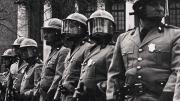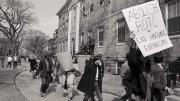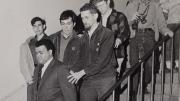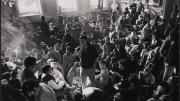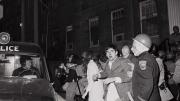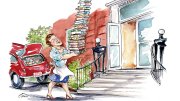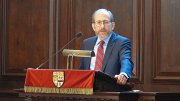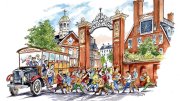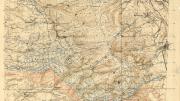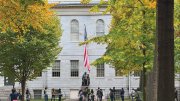In the late 1960s, American society seemed in crisis. The Tet Offensive that began in January 1968 underscored the scale, violence, and increasingly apparent fecklessness of the war in Vietnam. The combat itself had opened ugly class divisions between those drafted into military service and the large cohort of Baby Boom students enrolled in college and, at least temporarily, exempt. In late March of that year, President Lyndon B. Johnson withdrew his candidacy for another term—and days later, Martin Luther King Jr. was assassinated, igniting a period of convulsive urban violence that laid bare severe racial divisions and deprivation, and prompting fears about wider disorder. Presidential candidate Robert F. Kennedy ’48 was murdered in early June. Like the war itself, home-front turbulence spilled into living rooms that summer as the brutal Democratic convention in Chicago was televised. In this context, campuses were drawn into the wider turmoil—notably, with the occupation of half a dozen buildings at Columbia that spring.
Harvard seemed immune to those extremes—in part, some thought, because of the supposed cohesion created by its residential House communities. But campus controversies had already turned confrontational (the November 1966 demonstration against a visit by Secretary of Defense Robert McNamara; the October 1967 blockade of a recruiting visit by Dow Chemical Company, which supplied napalm to the military). And the same issues that agitated the wider society and fueled the national growth of Students for a Democratic Society (SDS) and similar groups—opposition to academic leaders’ engagement with military policy and institutional research seen as contributing to the war; the presence of ROTC programs on campus; University development in communities surrounding the Cambridge and Boston medical campuses; advocacy for a more racially diverse student body and curriculum—engaged and radicalized more members of the community. In December 1968, an SDS-led cohort tried to sit in on a faculty meeting focused on ROTC, forcing its postponement. The following February, although ROTC had been curtailed as an academic program with faculty appointments, the Harvard Corporation refused to terminate it completely. That March, after the faculty approved a degree program in Afro-American studies, students demanded further involvement in shaping curriculum.
On April 9, 1969, the day after SDS pinned a list of demands on the door of the president’s house, about 70 students forced their way into University Hall, evicted eight deans and other administrators of the Faculty of Arts and Sciences, and began rifling through files. At dawn the next day, on President Nathan M. Pusey’s request, local police officers and state troopers entered Harvard Yard and, in 25 minutes that included clubbing and bloodshed, forcibly evicted and arrested almost 200 of the occupying protestors, setting in motion wider protests, an eight-day strike, two mass meetings in the Stadium—and changes in University policy (the reduction of ROTC to extracurricular status and a student role in Afro-American studies appointments—a vote that future dean of the Faculty of Arts and Sciences Henry Rosovsky, an original champion of the program, denounced and later characterized as an “academic Munich”).
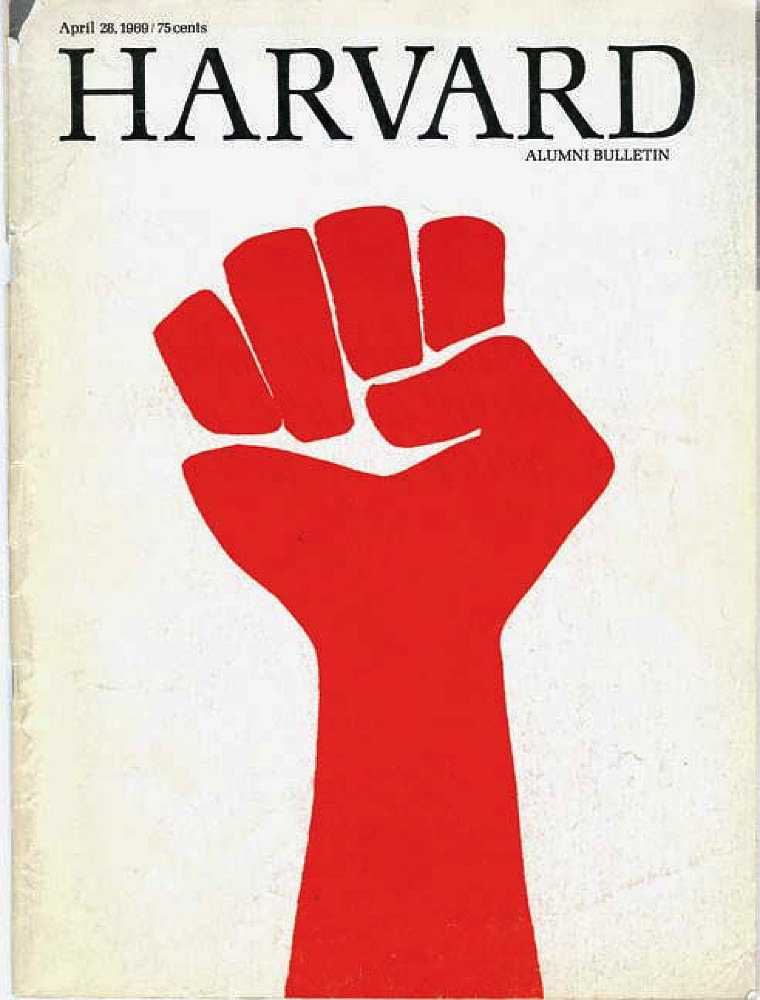
The images from that time remain vivid for those who lived through it (see “Through Change and Through Storm: Harvard, 1969” on exhibition until June at the Pusey Library). And spin-offs from the issues that fractured both the campus and the larger society remain very much contested terrain in contemporary political discourse.
A half-century on, Harvard Magazine republishes online Harvard Alumni Bulletin (as it was then known) editor John Bethell’s definitive real-time account of the campus as it was being torn apart, and his reflections a decade later. Supplementing those archival resources, we asked Craig Lambert ’69, Ph.D. ’78, who retired as deputy editor of the magazine in 2014 (after a quarter-century of service), to solicit recollections and reflections from participants in, and observers of, the events of that tumultuous spring and their aftermath. They appear here, with Lambert’s own take on what it felt like then.
~The Editors
By the time Harvard boiled over in the spring of 1969, the fever in Cambridge had been rising steadily since I’d arrived as a freshman in the fall of 1967. Proliferating campus political organizations were staging serial protests of varying intensity and ideological hues. The cataclysms beyond Harvard Yard’s gates—the Vietnam quagmire, the assassinations of Dr. Martin Luther King Jr. and Robert Kennedy, the riots of Chicago, and the ascent of Richard Nixon—had shaken everyone I knew. At the Crimson, where I was a fledgling writer on the editorial board, we took all this seriously (even as we took ourselves somewhat too seriously). Stoned and not, we talked late into the night on Plympton Street about politics and the war. But our abject fear of the draft notwithstanding, we felt safe in the Harvard cocoon.
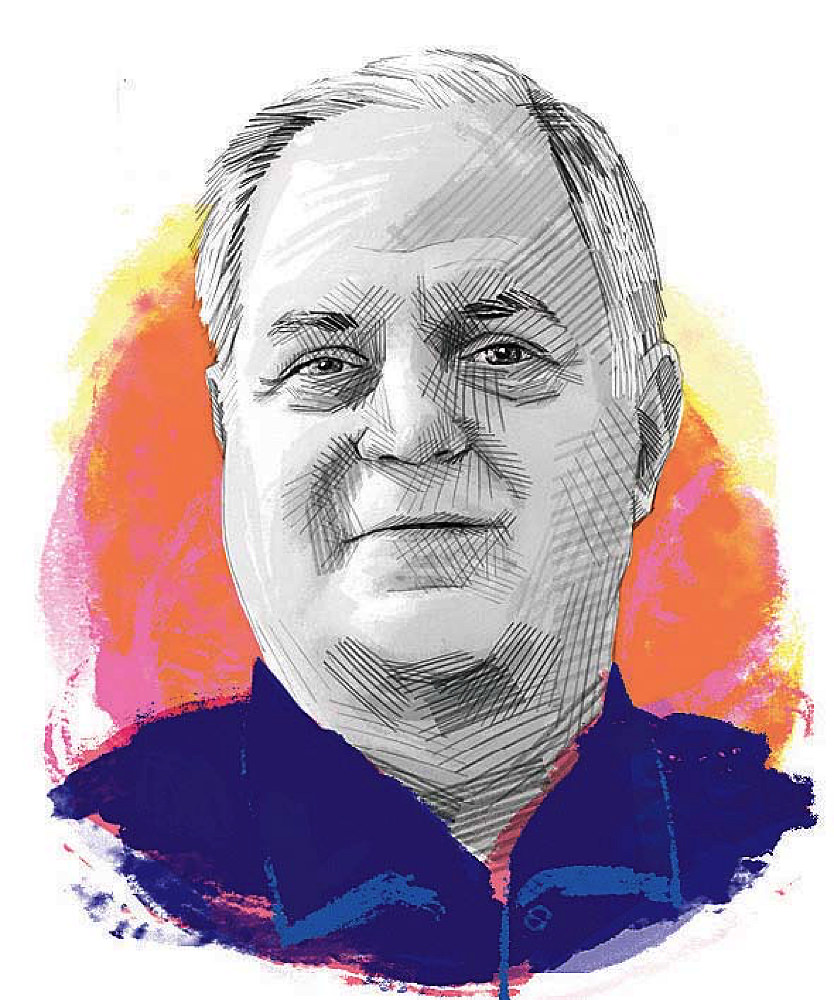
Frank Rich
Illustration by Luke Waller
Two weeks before the occupation of University Hall, the campus was roiled by a surreal bit of comic theater: a small itinerant group of Yippie-ish protestors led by a Columbia dropout known as King Collins started distributing impenetrable manifestos and staging pop-up demonstrations in Harvard dining halls. (The Crimson merrily ran a backside-only photo of a nude-in they staged in a House laundry room.) In retrospect, it was a relatively benign harbinger of the chaos that would engulf the University, much as the panicked public reaction to Orson Welles’s 1938 stunt radio broadcast, “The War of the Worlds,” is now seen as an omen of America’s entry into World War II. But I had an unexpected personal intersection with the Collins sideshow: as these protests subsided, a cousin of mine, a heretofore overachieving economics grad student at MIT, dropped out to “go underground” with this anarchist band. What was happening here?
On the fateful day of the University Hall occupation, Crimson staffers raced to the scene. To see Harvard administrators rudely hustled out of their offices was a shock. After that came many long hours of waiting—the atmosphere was alternately ominous and chattily festive—for a denouement we couldn’t imagine. There was still a sense that some sort of normality might prevail. In the tedious wee hours, an upperclassman editor earnestly worked with me on a feature I had written about a student film starring the undergraduate actor Tommy Lee Jones. Surely we’d all pick up where we left off before?
The arrival of the police in military formations, helmets glinting in the Yard’s lights, was terrifying. The screaming, the trampling, the blood on the steps that followed would set off not just a strike but months of angry debate and aimless seething among students and faculty. We hoped the war might end sooner rather than later. We thought Harvard might end. We thought the world might end. None of this happened, but for a while we had seen what it might be like if the earth violently cracked open and civilization as we knew it tumbled into the darkness below.
Frank Rich ’71 is a writer at large for New York magazine and an executive producer of Veep and Succession at HBO.
Most attending a protest fall in quickly with others. I did not. I entered University Hall alone and was still isolated when arrested 13 hours later, having drifted ghostlike, unattached, through the events. I’d arrived late to the circus to find would-be spies rifling files, scout leaders organizing food, hippies lounging in groups, revolutionaries arguing tactics. During meetings our ragtag army sprawled across the stately room under the dismissive gaze of old white men immortalized in marble busts and elaborately framed oils. Afterward, cumbersome furniture littered the hall like driftwood following a storm. I roamed room to room, feeling invisible, finally choosing cool darkness outside. Hunched on granite steps, hugging an iron railing, I watched knots of students tighten and loosen in muted lamppost light.
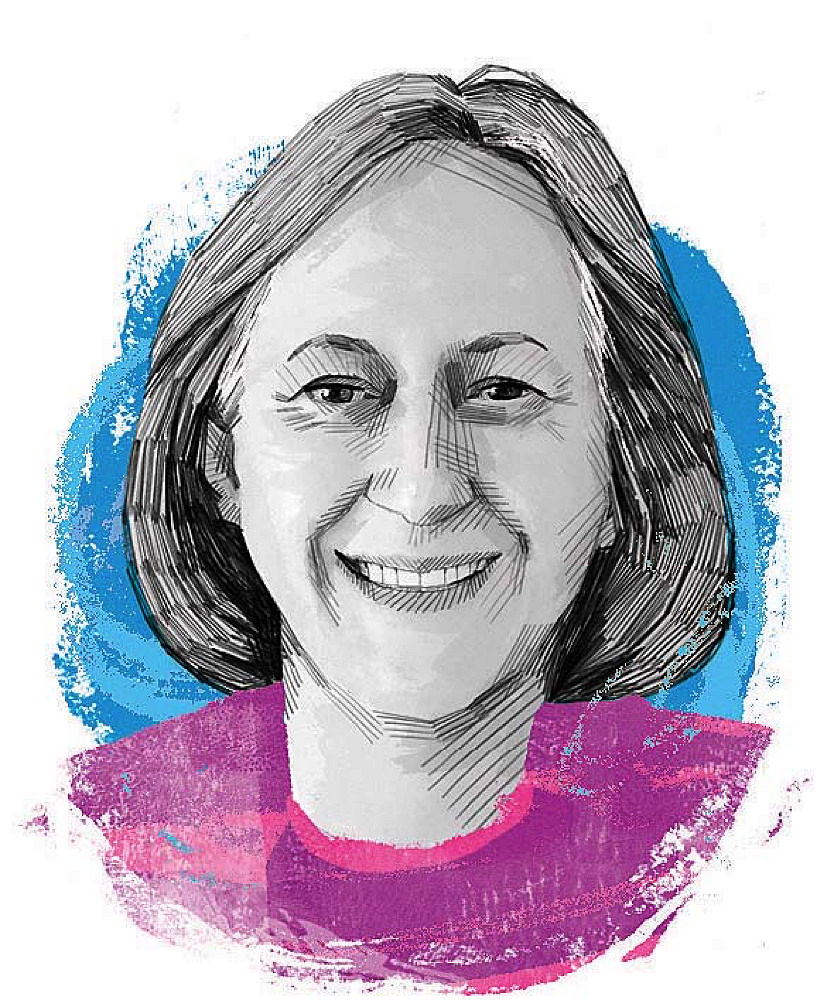
Jean Bennett
Illustration by Luke Waller
Earlier, someone had growled, “What’re you doing here?” I understood his skepticism, as I’d always been fiercely apolitical, shunningwar debates because my father, a gentle and perceptive diplomat whose life would be destroyed by Agent Orange, had volunteered for the Mekong Delta pacification program. I had found that choice impossible to embrace. But on April 8,wandering into an SDS meeting, I’d voted for action. The next day, returning to campus from volunteer work, I joined those I’d encouraged to act. My working-class neighbors felt Harvard’s squeeze, so President Pusey’s denial of the expansion issue transformed me from inactive moderate to accidental radical.
After midnight I curled up on a rug, nested amid whispering pockets, welcoming sleep on my pillow of hands. Before dawn the alarm sounded: “The pigs are here! Everyone downstairs!” The cops outside, framed through arched windows, weren’t my anticipated “boys in blue.” These were state troopers sporting sky-blue jackets and visored helmets. Each seemed a giant; each cradled a hungry baton.
Downstairs, the front line swallowed me. I stared at puny chains shackling twin handles of massive double doors, visualizing the bulge when wood would challenge metal, snapping a single link to let cops pour in. But our doors loomed immobile, silent. The melee, the screaming, came from behind. Having breached the southeast entrance, police were clubbing that other front line. With arms linked to others, I couldn’t turn around. That magnified my terror, hearing an attack I couldn’t see.
Then cops charged our line. Students on either side dropped my arms, returning me to solo action. Tailed by a trooper, I ran the maze of halls to its end and crouched against a glass partition, arms protecting my head, teeth chattering. He swung back the baton, his face revealing a workingman’s outrage at a spoiled brat flouting the law—his law. I was “the other”—entitled, educated, “unpatriotic,” brown. He yearned to club me, for understandable reasons.
My arm shot up, pointing to the glass wall.
“Hit that!” I shouted.
And he did, with a force that would have smashed my skull. The break spread out like cracking ice, shooting a web of lines across the glass until suddenly it surrendered and slivers crashed down like spiky, jagged rain. His anger had vanished. Did he feel a secret satisfaction in damaging Harvard property? Were we now partners in crime? Navigating the police phalanx that funneled us into the jail-bound bus felt oddly unreal. His stick kept jabbing me while I pretended a head injury, both of us playing our parts in political theater.
My father’s letter offered a healing balm: “If I believed what you believe, I would do as you have done.”
In May my father’s letter offered a healing balm: “If I believed what you believe, I would do as you have done. The only way this war will stop is if the American people turn against it.” On April 30, 1975, my father was evacuated from the roof of the American Embassy in Saigon, on the second-to-last helicopter out.
Jean Bennett ‘69, M.A.T. ’72, has taught every level from preschool to adult ed and always preferred the age she was currently teaching.
“Are the cops coming? Are the cops coming?” Everyone inside University Hall that morning seemed to be asking the same question with the same anxious yet eager emotion in their voices. Not wanting to sit, arms linked, with my fellow occupiers to take whatever blows the police might deliver, I volunteered to go outside and get an answer.
In the sharp, early-morning light, the police were already invading the Yard, their powerful car engines revving down and their tires digging deep ruts into the thick grass, wet with dew, between Widener Library and Memorial Church. I think I turned back to University Hall and knocked wildly on the doors, yelling, “They’re here!” But I may not have made that responsible gesture at all. Given the racket the police were making, it had become entirely superfluous.
I joined a swelling throng of students who were screaming at the police to get out of the Yard. Some shouted, “Sieg Heil!” and made a mocking Nazi salute. Those images of storm troopers came easily—too easily—to anyone raised on pictures of the big war that had ended less than a quarter-century before.
Then I did a stupid thing: I threw an empty soda bottle at a policeman; it rattled off his helmet. He charged after me with his billy club, landing a blow on the top of my head before a crowd of irate students surrounded me and forced him to retreat.
Then I did something that, in retrospect, seems inevitable. With blood trickling down my neck and onto my collar, I walked up the Widener steps and gave an angry speech denouncing the bust and calling for a student strike. Later that morning, an unruly mass meeting voted to shut down the University.
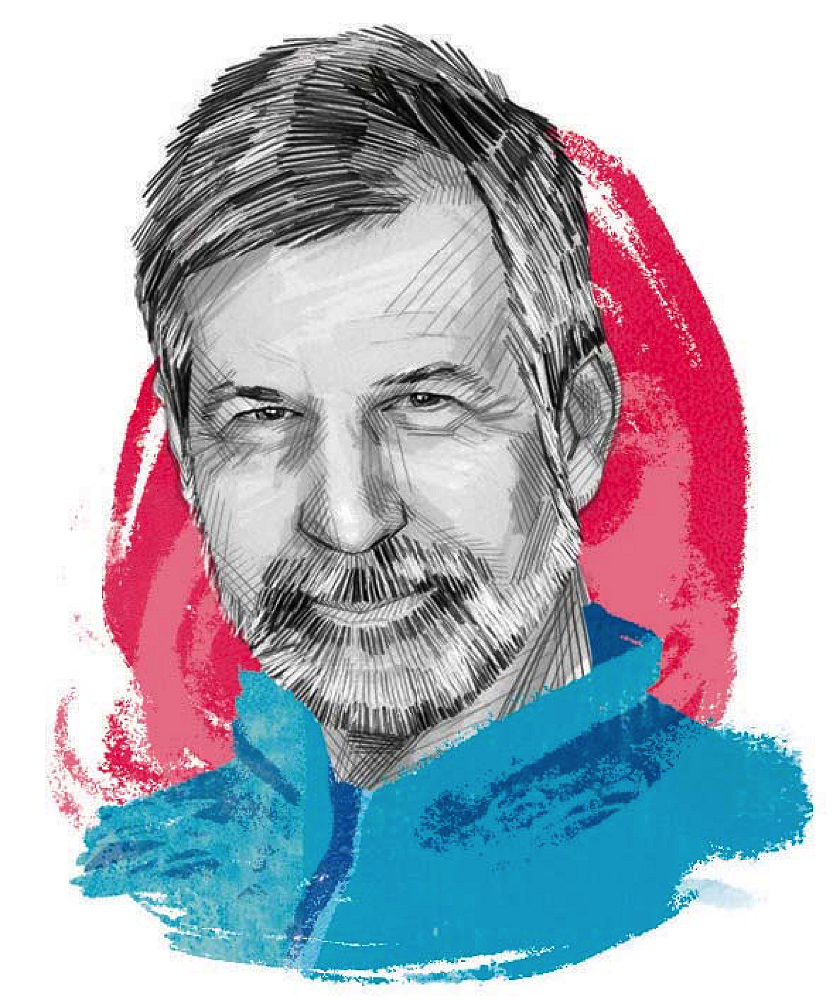
Michael Kazin
Illustration by Luke Waller
I felt guilty that I did not get arrested along with my comrades; that is probably why I hurled the ineffectual missile at the cop. But I felt exhilarated that President Nathan Pusey, by calling in the police, had instantly turned an act of civil disobedience by about a hundred radicals into an uprising by thousands of students and professors who were incensed that outside agitators in blue shirts and crash helmets had barged into an internal Harvard quarrel.
Did our actions help end the war in Vietnam any sooner? Did it matter that the issue that drove us to occupy University Hall—abolishing the local ROTC chapter—was not really the issue, but instead a handy way to dramatize Harvard’s undeniable “complicity” with the military-political-intellectual machine that had engineered and was prosecuting the profoundly immoral war?
On occasion, I ask my classes on the 1960s to debate these questions, which have no simple answers. But for a 20-year-old leftist who thought almost any act to protest the war was justified, the morning of April 10, with blood trickling down my neck, was a thrilling time to be alive. We were making history. Alas, to paraphrase Marx, not quite as we pleased.
Michael Kazin ’70 is a professor of history at Georgetown University and co-editor of Dissent (www.dissentmagazine.org). In the spring of 1969, he was co-chair of Harvard-Radcliffe Students for a Democratic Society.
For me, the central conflict of the occupation was between being an officer of the University and an active protester against the Vietnam War. Very few if any other Harvard administrators were in that position.
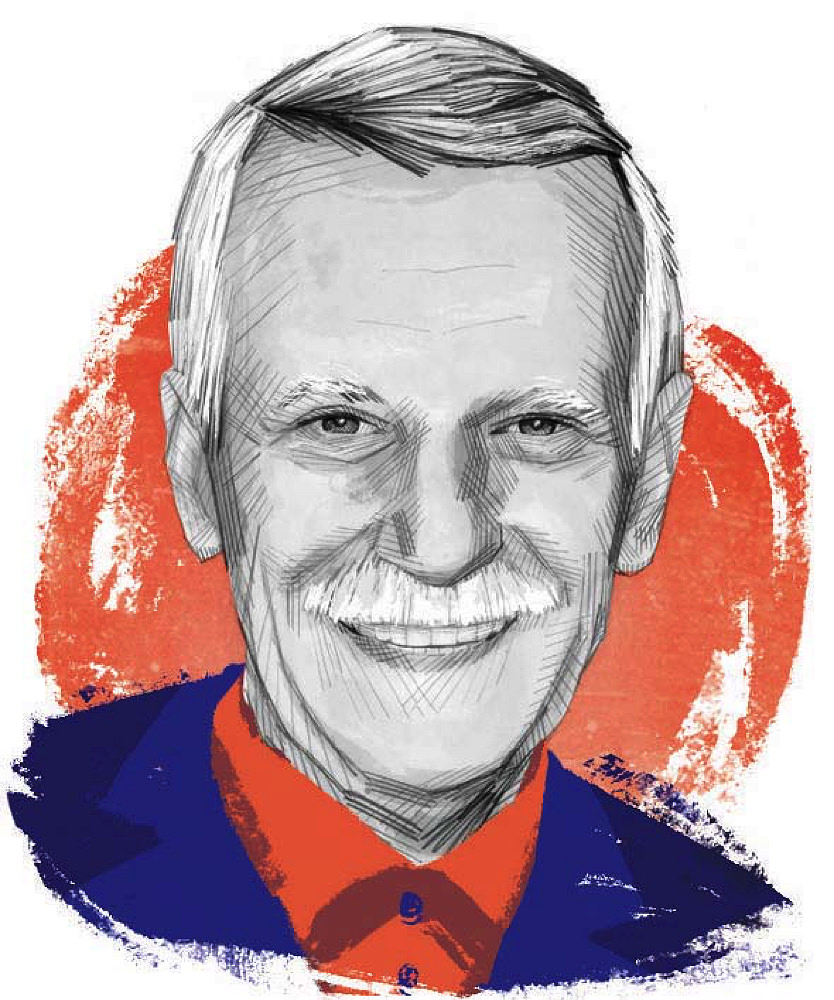
James E. (Jet) Thomas
Illustration by Luke Waller
Harvard Divinity School (HDS), from which I held two degrees, had been a center of opposition to the war from early on. I had joined a group of HDS students who chained themselves to the altar of the chapel, trying to prevent the arrest of a draft resister. I was also an ordained Southern Baptist minister who was doing a good deal of draft counseling, an assistant dean of freshmen, and a freshman-dorm proctor.
So when the first campus protests began, I felt conflicted. I also felt that by attacking the University rather than the U.S. government, the students were making a tactical mistake. Once the University was cast as the enemy, I worried that Harvard would take on a police role, and as we saw, subsequent events confirmed these fears.
I was in my office in University Hall when the occupation began. Some students walked in and said, “You have to leave, Jet. This building is occupied.” I refused to go voluntarily and explained why: I was opposed to the war myself, and felt that inserting the University between the protesters and the government was a mistake. “You’ll have to carry me out,” I told them.
Which they did. One student picked me up and carefully lifted me over his shoulder. As various things fell out of my pockets, others picked them up for me. When he put me down in the hallway, a rather crazy student ran up and tried to hit me. Others grabbed him, though, while I got hustled out the door. Otherwise, no violence was directed at me.
After the occupation had ended, I was appointed to the Committee on Rights and Responsibilities, charged with determining what was acceptable protest and which students deserved punishment. I wound up defending the student who’d carried me out of my office. Violent? No, he was not, I said.
Looking back, I think that Harvard, like most institutions at the time, felt it had little to do with this student-led movement. Even though many faculty members actively opposed the war, it was almost unseemly for a Harvard administrator to join a protest march.
On Harvard’s Administrative Board (of which I was also a member), there was further conflict between what senior tutors and graduate students thought the University should have done (take little action and let the occupation run its course), and what upper-level administrators thought. These men, who were older and not as close to the students, had decided that a firm response was needed. By choosing to call in state police, they changed the whole mood of the student body and faculty, leading to a lot of anger and, ultimately, the shutdown of the University.
Great damage was done to Harvard by all this. I think the University has never been the same since. But I guess that’s true of the whole country.
The Reverend Doctor James E. “Jet” Thomas, S.T.B. ’65, Th.M. ’67, taught at Marlboro College for almost 28 years; he now lives on the side of a mountain near Asheville, North Carolina.
By the time my boyfriend and I arrived at University Hall that spring of my sophomore year, the building had already been broken into and taken over. We wanted to protest the war, but didn’t feel ready to invade the building, so we joined the charged-up crowd that was quickly growing outside on the steps.
As midday approached, I decided I needed to temporarily leave my position on the steps in order to get to my other position, as a waitress serving lunch at the Signet Society. The Signet was a (then all-male) literary club that, although only a few blocks away, felt like it was on a different planet, one where young men were still opining about poetry, not napalm. When I returned to the University Hall steps after lunch, papers were floating down from the second story as people hurled files out the windows.
Reprisals from the Harvard administration were expected—even desired—to generate the attention we wanted to bring to the war. Rumors about what might happen escalated as night descended and we waited. Then, right before dawn, a massive force of police stormed toward us in full riot gear with billy clubs and Mace. At first, only the people inside were dragged out and arrested, but soon people outside, too, were getting their heads bashed in and bodies bloodied. As the cops began to attack, my boyfriend and I held our ground for a few defiant moments. Then we ran.
A week or so later, it felt like the whole outraged school—faculty and students—was cramming into Harvard Stadium. The administration had inadvertently accomplished what we had not: bringing the message home. If Harvard alumni had designed and perpetrated the war, its current students and faculty were now voting a resounding Yes in favor of a strike to shut the University down.
My school life was never quite the same. My boyfriend and I split up, and I managed to avoid University Hall for the rest of my college career. I graduated wearing an armband emblazoned with the women’s symbol and a “strike” fist over my academic gown.
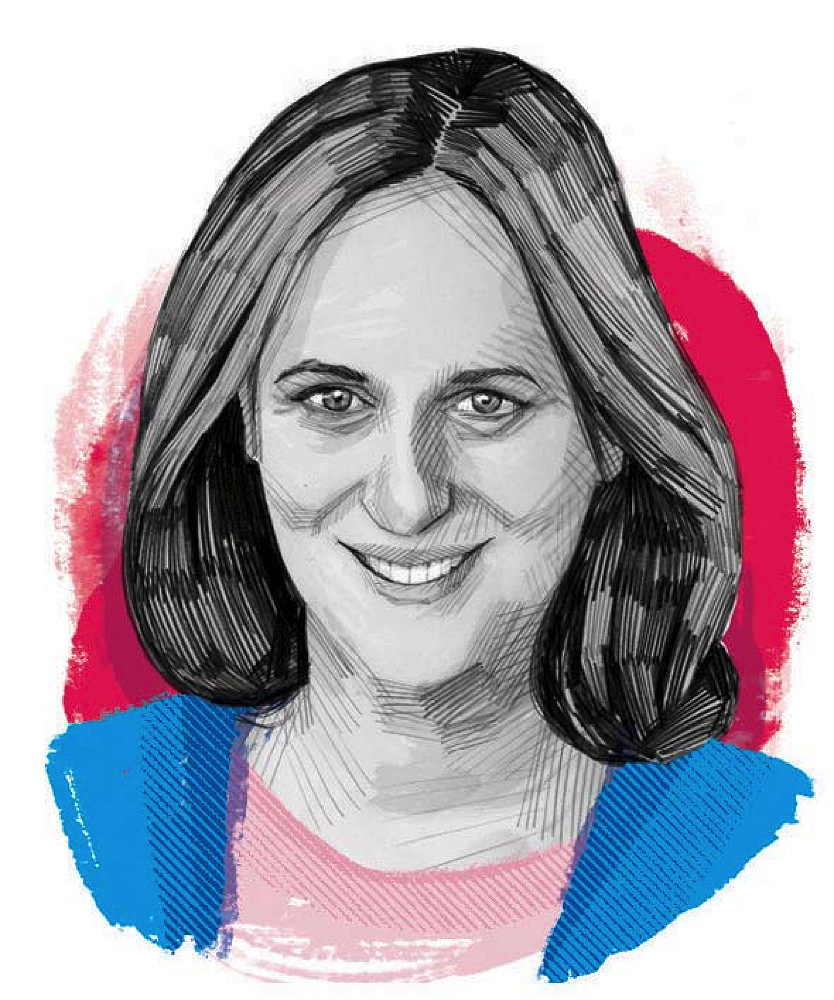
Lucy Fisher
Illustration by Luke Waller
Then, almost 40 years later, I was unexpectedly nominated for the Board of Overseers. Although my work in the film industry might have qualified me as a token “arts” member of the Overseers, back in Cambridge it still felt pretty Establishment to me. One day, while walking to meet with the dean of the humanities to lobby her for more creative writing courses, I searched for her on-campus address on my phone and there it was—University Hall.
As I walked up those steps once again after so many years, I felt almost out-of-body. I couldn’t help but wonder how much of the girl I had been before was still inside me. I also couldn’t help but wonder about those heady days. It certainly felt like we had really changed things. But looking around today—clearly not enough.
Lucy Fisher ’71 is co-head of Red Wagon Entertainment, former vice chair of Sony Pictures Entertainment, and president of the Producers Guild of America.
I remember April 9, 1969, vividly. A group of us from Lowell House were playing touch football on the fields of the Business School. I made a great over-the-shoulder catch and ran away from my roommate for a touchdown. Fifty years later, I still believe it was the athletic highlight of my life.
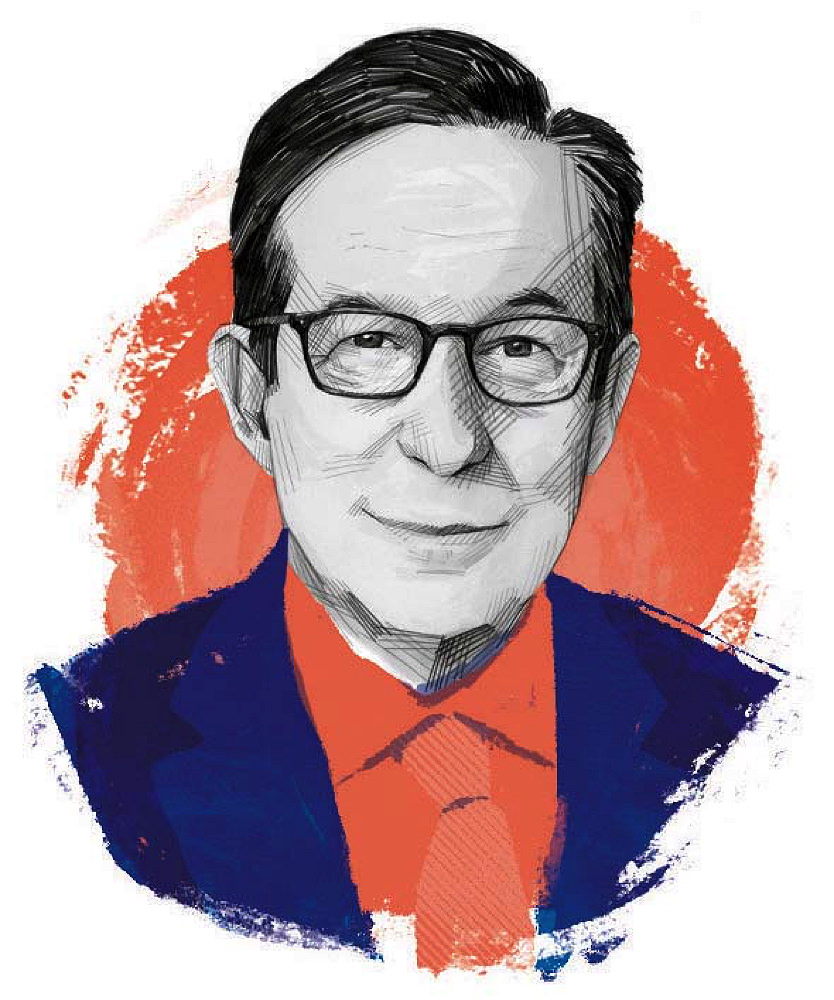
Chris Wallace
Illustration by Luke Waller
At some point, word spread from across the river that some students were protesting at University Hall. Reluctantly, I remembered my duties as a reporter for WHRB and headed over. When I got there, I realized this was a big deal. Members of SDS had taken over the building, ushered out administrators, and even carried out a dean. Once inside, I discovered that my colleagues from the radio station had appropriated the office of Franklin Ford, dean of the Faculty of Arts and Sciences, as our studio.
There was a giddy feeling. From serious protestors to hundreds more along for the adventure, there was a sense of, “Look at what we’re doing.” Some students found the academic files and searched for their records. There was a lot of talk about what would happen next. And from our anchor booth, we stayed on the air all night, doing interviews and play-by-play.
But at some point, the mood began to change. As dawn was just breaking, I saw big, beefy policemen appear through the mist in Harvard Yard, and mass at the doors. For the first time outside of a movie, I saw a battering ram. And I saw the police break open the locked doors.
They cleared out the protestors quickly. Maybe it was my fevered imagination, but they seemed to take special delight in getting their hands on a bunch of Harvard boys. I brandished my WHRB card and shouted, “Press! Press!” like Woodward or Bernstein. The cops couldn’t have cared less.
All of us were hauled off in buses to the Middlesex County jail, where we were crowded into cells. The barred doors clanked shut. This was very exciting—for about half an hour. Then boredom and fatigue set in.
When I got my chance, I called the radio station and did a report from jail. And caught up in the moment, I signed off my phoner, “This is Chris Wallace in custody.”
There was one high point. Eventually, we were each allowed to make our one phone call from jail. Some of my classmates called their roommates. Others called their girlfriends. When I got my chance, I called the radio station and did a report from jail. And caught up in the moment, I signed off my phoner, “This is Chris Wallace in custody.”
Chris Wallace ’69 is the anchor of Fox News Sunday.
After the police action at University Hall, I attended a large meeting in Memorial Church, put together almost entirely by a group of undergraduates. I supported the decision of this gathering to convene a large meeting of the Harvard “community” in Harvard Stadium.
I ended up chairing this Stadium meeting, plus a second one, as the result of a discussion with two or three Radcliffe undergrads who were among a group of undergraduates working on developing a community response to the bust. They lived in Radcliffe’s Holmes Hall, where my wife and I were senior residents.
These students had told me a day or so after the bust that they weren’t sure they were on the right track. I encouraged them to continue what looked to me like pretty savvy action. I also invited them to call on me anytime, having no inkling of having any further involvement.
The next day they returned to say that they could not find anyone willing to chair a meeting of the community in the Stadium. They asked me to, and I agreed, on the condition that I would be empowered to review, change, and approve plans. They consented to this.
Having played a leadership role during my junior and senior years at Kent State University in the movement for equal rights in housing for that university’s minority students, I had developed at least some skills in managing large groups, though nothing at the scale of what was planned for the Stadium.
Two aspects of the Strike and, particularly, the two Stadium meetings, stand out in my mind.
First, the impressive organizing skills of the Harvard/Radcliffe students working with other undergraduates (and, likely, some graduate students as well), to plan and get the University’s agreement to use the Stadium.
Second, the concern of most students, faculty, and administrators (across all academic units) to preserve the Harvard community.
I recall the meetings themselves as having the following general character and tone:
First meeting. This meeting was essential, both as an event and in its results. There were competing objectives. Radical groups wanted to keep Harvard on strike until their several demands were met. More moderate forces hoped that the meeting would bring the Harvard community together toward a fairly quick de-escalation of the crisis and a return to normalcy. The radical groups wanted to prolong the strike in hopes (not terribly realistic) of some sort of restructuring of the University. The event did, in fact, fulfill the moderate hopes. That a meeting of some 10,000 people accomplished that is, in itself, remarkable.
Frankly, I was in a zone of confidence, thanks to the remarkable work of the students who created and managed the two Stadium meetings.
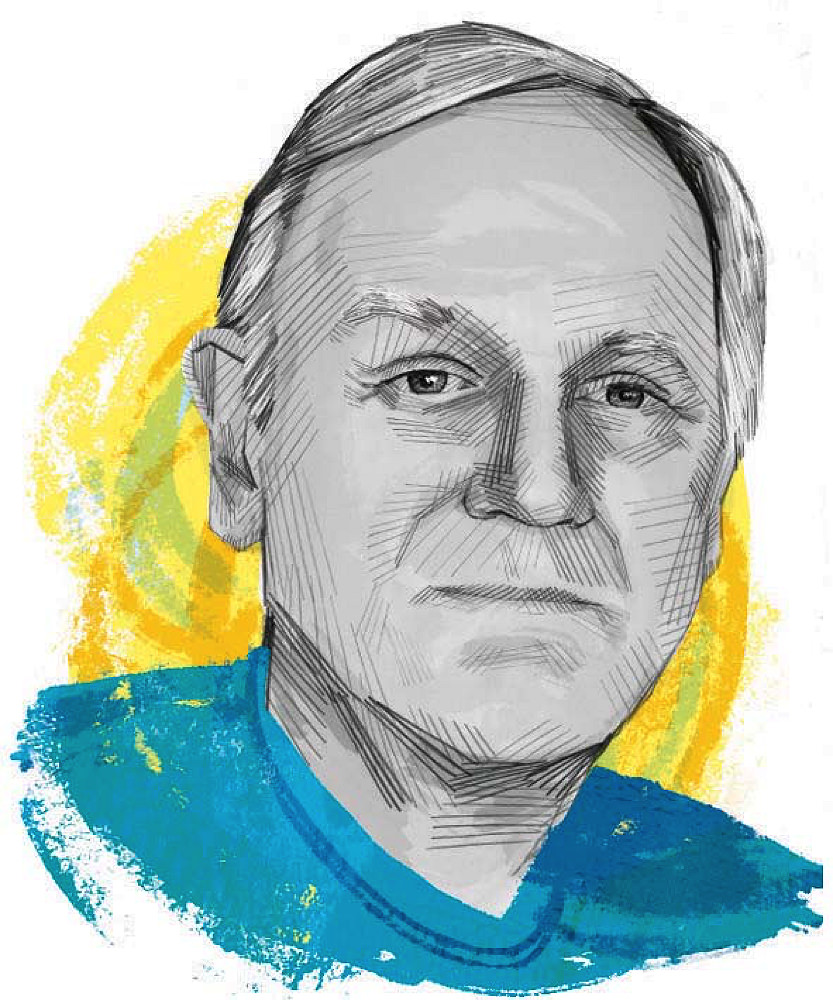
Lance C. Buhl
Illustration by Luke Waller
Second meeting. Though important as a culminating “community” event, this meeting was not nearly so well attended. It had little result, save to underscore that the community “crisis” had ended.
Though the meetings were certainly significant, not nearly all the issues in play were elaborated, much less addressed—especially the concerns of minority students.
Lance C. Buhl, Ph.D. ’69, is a retired business and nonprofit executive and consultant. After working with British Petroleum’s corporate contributions program in the United States from 1981 to 1993, he was a consultant to scores of foundations, corporations, and nonprofits.
Among the many threads woven throughout the strike was how the larger strike movement would embrace and support black-student demands for the establishment of a department of Afro-American studies. Although late in January 1969, the Faculty of Arts and Sciences had approved the establishment of a degree-granting program, there was some faculty resistance to calling the entity a department. In the aftermath of the University Hall takeover, the crisis atmosphere created an opportunity to revisit the status of the program.
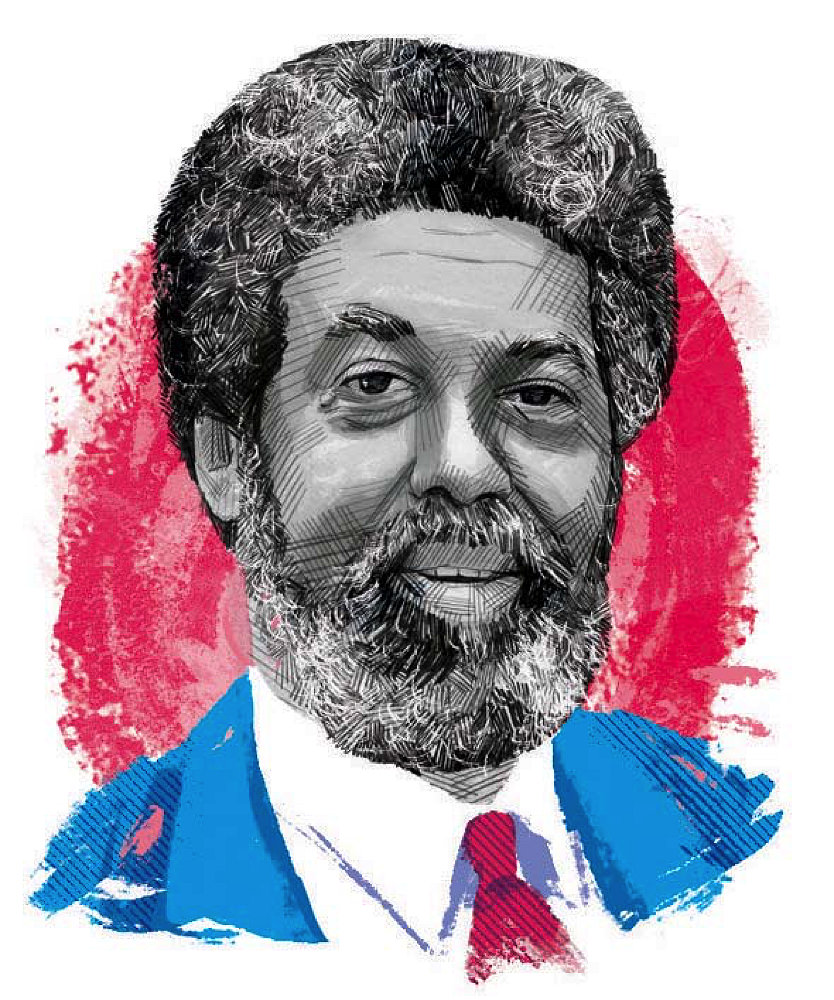
Robert L. Hall
Illustration by Luke Waller
In this crisis atmosphere, a rumor apparently circulated that black students were going to storm Widener Library, destroy books, and, to the great horror of some faculty, empty the card catalog. Where this rumor came from is a mystery to me; certainly I had never heard a black student suggest this at any of our numerous strategy meetings (frequently held in Phillips Brooks House, whose president was one of my black classmates, Wes Profit).
One evening, during a break in a meeting, a reporter asked several of us if this rumor was true, and intimated that a group of faculty had barricaded themselves inside Widener to stave off the barbarian hordes. About a hundred of us decided to have some fun, and marched up the steps to the front door of Widener, one by one pressed our black and brown faces against the glass door, said “Boo,” and walked to a common room in another part of the Yard to continue our meeting. In retrospect, this may not have been the wisest tactic, as our playful action probably convinced the vigilance committee that we indeed intended to desecrate the library.
In 1992 I had an awkward encounter with Oscar Handlin, then emeritus professor of history at Harvard, during a gala dinner at the American Academy of Arts and Sciences celebrating the centennial of the Colonial Society of Massachusetts, of which I am a life member. By the time I had worked the room, only two seats remained, and my wife and I had no choice but to sit at the same table with Professor Handlin and his wife, Lillian. Not thinking that he would remember me, I introduced myself. Raising his voice somewhat, he said, “I know who you are!” Then I said, “And you probably think that back in 1969 the black students were going to invade Widener.” Handlin poked me in the chest with his stubby fingers and said in a still louder voice, “You were! You were!” After my wife separated us, we sat down and enjoyed a remarkably cordial dinner.
Robert L. Hall ’69 is associate professor of African-American studies and history emeritus at Northeastern University.
Just as Dick Bulliet, formerly of the Center for Middle Eastern Studies, used to say that all human beings are born with the ability to read Italian, so I was born with an innate horror of the vast majority of German political philosophers (there are so many you can’t count them). Thus, in ‘67, when a fellow undergraduate, a disciple of Herbert Marcuse, spoke of burning Widener and replacing its contents with the scribbles on the cover and inside his ratty spiral notebook, I had a shiver of clairvoyance.
Two years later when University Hall was occupied, the black gates of the Yard were chained, but climbing over them was easy. This I did after peering through the basement windows of the firehouse, where hundreds of police in riot gear were beginning to move out. I ran to the Faculty Room, stood on a table, announced the imminent assault, urged the occupiers to disperse like the guerillas they so admired, and was shouted down.
I wanted to prevent the clash of police and mainly young girls whom the occupiers had maneuvered to the entrances—and a bloody clash it was—but the leaders stated that they wanted to “radicalize the buzhies [bourgeoisie].” Perhaps you didn’t know that Radcliffe girls were the bourgeoisie. The leaders themselves escaped out the statue side of the building, and one of them—recently I read a piece he wrote from his tenured perch—told me that Mao said the leadership must be preserved. Pace the boy lying on the ground, against whose head a policeman had broken his wooden nightstick. (Perhaps, before it struck his head, the stick hit the ground.)
Just as an infant takes his first steps with daring rather than knowledge, the young and perplexed can be forgiven seeking their guidance in action itself. But they cannot be forgiven the instantiated impulse to destroy that which—with the broadest, most imprecise, and suspiciously self-serving brush—they promiscuously tar as evil. Though civil unrest did hasten both the end and the loss of the Vietnam War, Harvard neither started nor was capable of ending it, and should not have been treated as justifiable collateral damage.
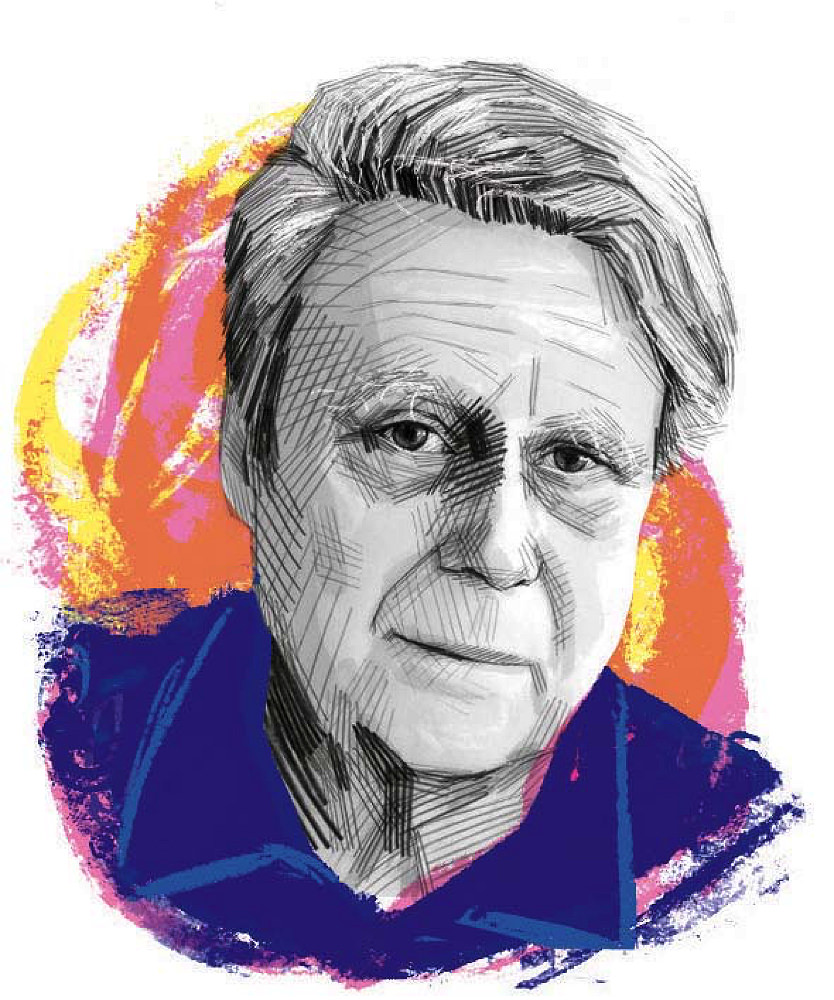
Mark Helprin
Illustration by Luke Waller
I suspected then that my perspective would change were I lucky enough to live a further half-century through war, death, estrangement, divorce, poverty, riches, sickness, and lawsuits. It has and it hasn’t. Then as now, I was suspicious of revolution and fundamental transformation; I believed that, if resorting to violence, one should be extraordinarily cautious, and willing to stand on the front line rather than running out the back while others take the hit; and I felt revulsion at hatred of the American Constitutional system by those infatuated with murderous revolutionary dictatorships abroad.
I felt revulsion at hatred of the American Constitutional system by those infatuated with murderous revolutionary dictatorships.
My horror of German political philosophy has been empirically supported with every passing year. And Millennial snowflakes have confirmed the disdain I felt for Harvard’s exquisitely delicate self-examination afterward, which may have marked the birth of today’s grief counselors to those who have lost no one.
The latest novel by Mark Helprin ’69 is Paris in the Present Tense.
I was supposed to be a government major. I ended up majoring in Messy Intergroup Negotiations. My classrooms were long meetings with black students at midnight strategy sessions in Leverett House; negotiating with senior Harvard administrators in University Hall; and debating senior faculty members in their offices. The final assignment was helping lead a team to create Afro-American Studies at Harvard. My final grade was probably an incomplete—a grade that stood for about 20 years, until the department achieved its hoped-for potential.
For many black students, the political eruptions of mid-April 1969 around the University’s complicity in the war in Southeast Asia held second place to the struggle around Harvard’s complicity with its legacy of racism. The SDS takeover of University Hall and the administration’s brutal response of calling in the police collided with the yearlong process then underway of crafting an Afro-Am academic program. The sharp point of the collision occurred when on April 9, the day of the occupation, a faculty subcommittee released a draft of the defining document that went against one of the students’ core principles—that the new department be a freestanding academic unit with its own power over course content and standards.
Some students called the fight against institutional racism the “eighth demand,” tacked onto the initial seven SDS demands. But for black students, it was always Demand Number One. For us, confronting legacies of racism was a deeply felt personal and institutional imperative, lived daily on campus and beyond.
That day, as I was sitting in our student “war room,” Bob Hall [see above] ran in and asked, “Have you seen this shit?” It was the faulty faculty draft. My immediate reaction was, “Oh man, this is a mess.” Next thought: “We can get together and fix this.” But as I considered the political realities, I understood that it was probably an unfixable mess.
It was an important early lesson for me in the costs of a failure to communicate—costs that all parties would pay. We began a new round of discussions, but things had gone too far to return to the status quo ante agreements. We negotiated newer terms in a rush.
Communication had indeed broken down within and between the parties—the black students and the white faculty, with both groups splintered. Trust had been assumed to be strong when it was in fact fragile, and needed constant tending. In the cauldron that was Cambridge in 1969, and indeed on the national scene, as martyrs white and black were slain one after the other, trust was in very short supply. As James Brown sang, “Things done got too far gone.”
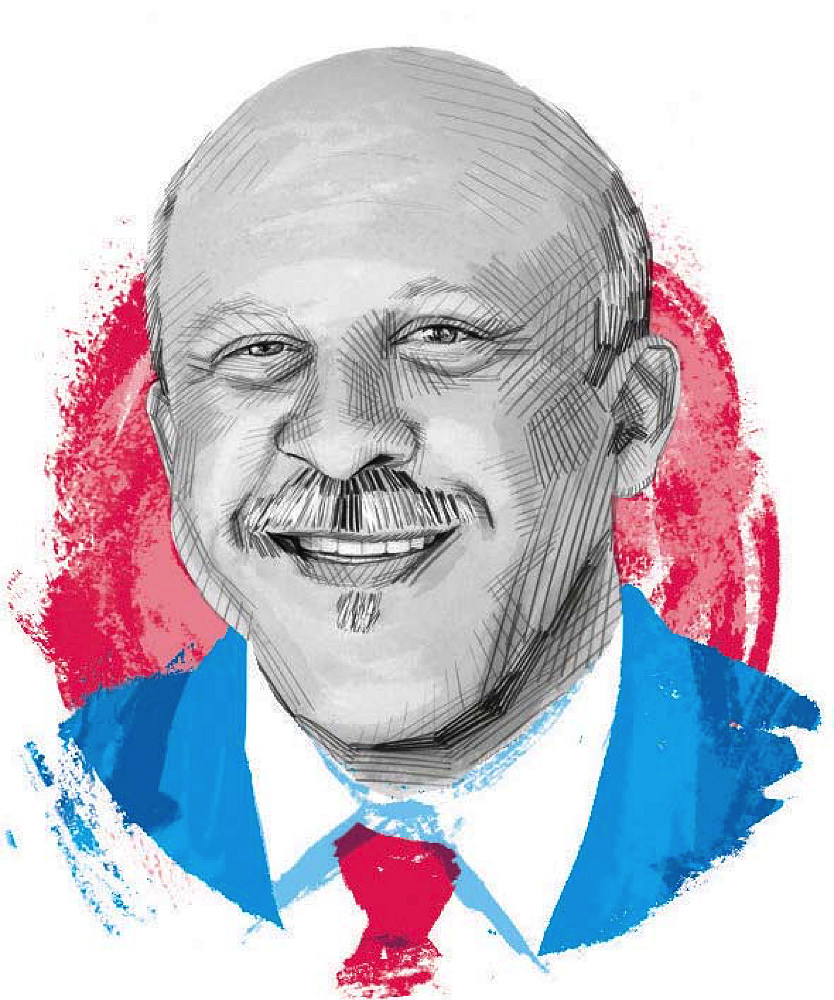
Ernest J. Wilson
Alas, it took nearly 20 years to fix the excesses and deficits of University and departmental commitments to get black studies back on track. The final product reflected the initial core values we sought. But it was not a walk in the park.
Those difficult days in Cambridge continued to shape my views of the world. When I was appointed to the senior staff of the National Security Council at the White House, those lessons were invaluable as I helped negotiate the U.S. role in the transition from apartheid to freedom in South Africa. They were also front-and-center when in 2007 I was appointed dean of the Annenberg School for Communication at the University of Southern California. I arrived deeply committed to teaching diversity, empowerment, negotiation, and other “soft” skills in a world in turmoil. For me, helping the underprivileged to speak more forcefully and clearly, and urging the powerful to listen better, is a worthy outcome learned in those early days in Cambridge.
Ernest J. Wilson III ’70 is professor of communication and political science at the University of Southern California.
The unintended consequences are what most intrigue me today about the occupation of University Hall. They seem to me more profound, and longer lasting, than its political effects.
The occupation sparked the abolition of ROTC at Harvard and sent the message that the country would remain ungovernable as long as the Vietnam War continued. And yet, though it helped end the war, the movement of which it was a part was unable to achieve its longer-term goal, namely to convince Americans to avoid such ill-conceived wars in the future.
The enduring changes I have in mind—the unintended consequences—were those that took place at Harvard. Even before University Hall, many understood that the time had come to rethink the College’s cultural norms and educational system, but there was no resolve and therefore no action. The occupation broke the logjam. Emblematic is the issue of the dress code—the requirement that male students wear coats and ties to all meals. The rule made little sense once a majority of Harvard freshmen were recruited from public schools, where coats and ties appear only at special events. Though we disliked the dress code, it seemed too petty a matter to excite a protest. And yet, even without being asked, the College discreetly abandoned it after the bust. Parietal hours were similarly obsolete. We had cars in high school, there were drive-in movies, and contraception was coming into widespread use. After University Hall, parietal rules, whatever their official status, were no longer enforced.
The occupation and the bust also provoked introspection about those aspects of the intellectual environment that we would today consider inflexible, even a bit unfriendly. For example, in the following years, the faculty created a more meaningful Gen Ed curriculum. Soon, the social studies honors concentration was no longer restricted to a small group of hand-picked students, but was opened to anyone with a workable project. Interdisciplinarity gained ground. Relations between students and faculty slowly improved. Once the dam broke, other types of change came up for discussion. The ensuing debates increased sensitivity to gender, racial, and ethnic differences and expanded the role of women and minorities.
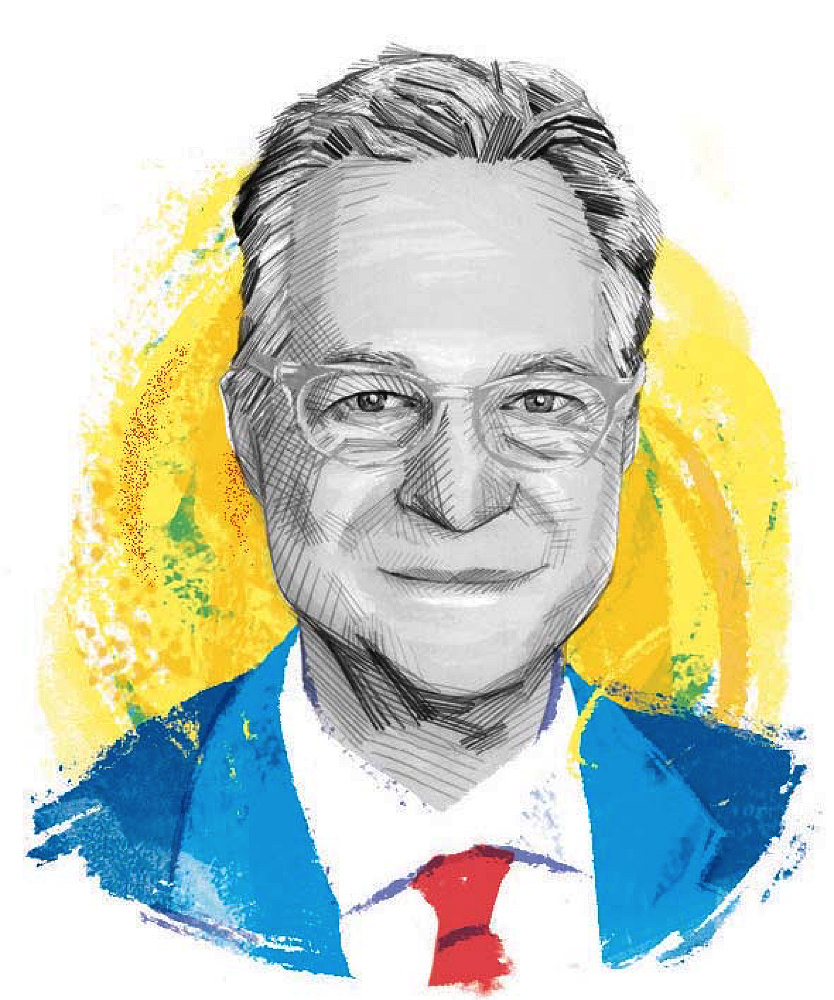
Richard Hyland
Illustration by Luke Waller
In other words, the occupation did more than provide Harvard with its own marker for the epochal transformation known as the 1960s—something else we have that Yale and Princeton do not. After the (figurative) rubble was cleared away, there was suddenly space to create a new Harvard. In a faculty meeting held shortly after the bust, Professor [Alexander] Gerschenkron likened the protestors to the brute in the fairy tale who destroyed a remarkable clock. Though at the time I found the metaphor silly, it now seems almost apt. Yes, we smashed an intricate timepiece, but since that clock had become a white elephant, the occupation proved to be worthwhile, even from an institutional point of view.
After the (figurative) rubble was cleared away, there was suddenly space to create a new Harvard.
Most of these changes would have happened anyway. The Sixties were powerful enough to have their way, with or without University Hall. What the occupation contributed was a sense of urgency—without it, Harvard would have taken much longer to become modern. Though no one foresaw this result, our presence for a day and a night in the faculty sanctum cleared the way for the making of today’s Harvard.
Richard Hyland ’69, Distinguished Professor at Rutgers Law School-Camden, participated in the occupation of University Hall. He is now at work on a book about Harvard in the 1960s.
Craig Lambert Reflects
The Late Sixties might have been the most exciting time ever to go to college. And the final semester of my senior year ended the joyride with a bang.
In early spring of 1969, the atmosphere at Harvard felt unlike anything I have experienced before or since. The air seemed charged. For about two weeks, student conversations at every table in House dining halls had only one possible topic: the SDS-led uprising and its demands of the Harvard administration. This must have been how it felt—on a much grander scale, to be sure—in the Paris cafés of 1789 or St. Petersburg salons of 1917. The entire campus was politicized, engaged, and in a sense, enraptured.
The University Hall occupation of 1969 is as good a landmark as any for dividing two cultures: the settled landscape of pre-Sixties life, and the endlessly disrupted one ever since. What was unearthed then has never gone away. The Late Sixties mantra that eventually became a bumper sticker is now an integral part of American culture: question authority.
